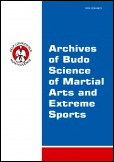2014, Volume 10, Issue 1
Refereeing errors as the cause of escalation of emotions and increase in possible health and life hazards during football match – the method developing competence of team sports and combat sports referees as the part of improving their qualifications
Piotr Łącki1, Jan Supiński2
1University of Wrocław, Wrocław, Poland
2Academy of Physical Education in Wrocław, Wrocław, Poland
Full text
Abstract
Background and Study Aim: Distortion of final score of a match occurs as a result of misjudgement made by referees during football competitions. The aim of this paper is to recommend the SET method (Ger. Schiedsrichter-Entscheidungs-Training) as an appropriate tool to verify the competence of referees.
Material and Methods: The method (SET) developed by the German Football Association may also be used in other sport disciplines to train referees in decision-making process. Our suggestion relates to modelling aggression risk (interpersonal and/or transferred) among fans, the risk of health or life threats to the referee as well as the likelihood of score distortion caused by refereeing errors.
Results: Similar training method has been used for several years in other sport disciplines (volleyball, judo). During judo training sessions (at least twice a year) referees analyse approximately sixty video-taped actions from leading sport competitions (European Championships, World Championships, the Olympic Games). During training course referees watch separate actions and enter their decisions into the score sheet. The most important justification for the recommendation to use the SET method in training referees of other sport disciplines is the possibility to modify it and adapt to various situations that occur in team sports and combat sports (especially judo, wrestling, basketball, volleyball).
Conclusions: The SET method in combination with modelling of aggression risk and the likelihood of score distortion due to refereeing errors may be especially useful in studies concerning extremity of team sports because of the separate criteria for the likelihood of undesirable behaviour in sport.
Key words: extreme situation, specific training, practical error, set method





